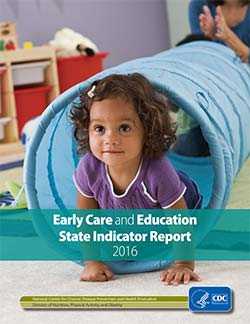Early Care and Education State Indicator Report
CDC releases first-ever Early Care and Education (ECE) State Indicator Report
The CDC's Division of Nutrition, Physical Activity, and Obesity released the 2016 Early Care and Education (ECE) State Indicator Report. This report provides information about state efforts to address childhood obesity in the ECE setting.
Early care and education (ECE) is a key setting to address childhood obesity for children under 5.
- 41% of U.S. children aged 0 to 5 years are cared for weekly in non-parental care arrangements, such as child care centers, family child care homes, pre-kindergarten classrooms and Head Start programs; 64% for children 3 to 5 years of age.
- About 1 in 4 children aged 2 to 5 years are overweight or have obesity.
- Children who are overweight when they enter kindergarten are 4x more likely to have obesity in 8th grade compared to their peers who are normal weight1.
- Because childhood weight status often tracks into adulthood, it is important that we reach children at an early age.
The Spectrum outlines 11 unique avenues by which states or communities have successfully changed ECE facilities to improve nutrition, physical activity, breastfeeding support, and reduced screen time among children aged 0 to 5.
This first-ever report looks at how states are doing in 7 of the 11 areas outlined in the Spectrum of Opportunities.
The State Indicator Report showcases key accomplishments, especially in 3 areas of opportunity.
- Licensing: Of 25 states that made licensing updates from 2011-2014, all included obesity prevention. Mississippi leads the nation meeting 15 out of 47 high impact obesity prevention standards.
- Quality Rating and Improvement Systems (QRIS): Of the 39 states that have ECE quality ratings, 29 include obesity prevention standards.
- Professional development: 42 states offered online professional development for ECE providers covering obesity prevention topics.
1Cunningham, SA et al., Incidence of Childhood Obesity in the United States. New England Journal of Medicine. 2014
CDC's Spectrum of Opportunities for Obesity Prevention in the ECE Setting is a guide for achieving the recommended obesity prevention standards and best practices in the ECE setting.

Continued support and progress is important if we are to prevent the problem of childhood obesity across the U.S.

CDC and other federal agencies are funding all 50 states and D.C. to address childhood obesity prevention in ECE settings. They continue to deliver training, tools, and resources to state and local health agencies and ECE providers to help young children develop healthy habits.
CDC also supports learning collaboratives consisting of ECE providers to make improvements in nutrition, breastfeeding support, physical activity, and screen time. Finally, CDC leads public-private partnerships dedicated to advancing research, policies, and practices that promote obesity prevention in the ECE setting,
State health departments and other key ECE stakeholders can use the Early Care and Education State Indicator Report to guide future efforts and inform decision makers about existing policy and system supports for ECE obesity prevention in their state.
- Page last reviewed: October 21, 2016
- Page last updated: October 21, 2016
- Content source:


 ShareCompartir
ShareCompartir
